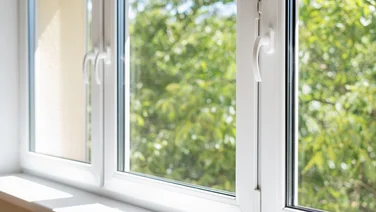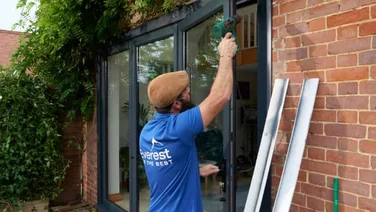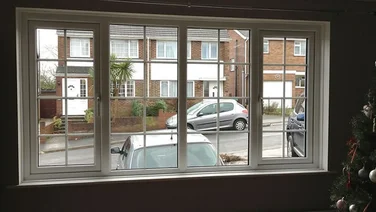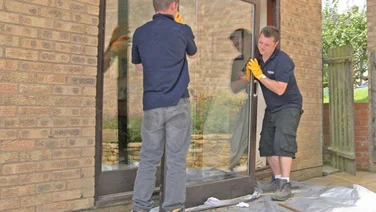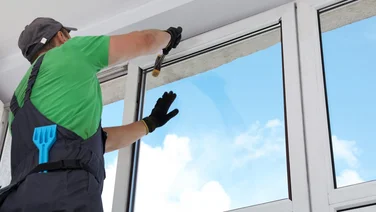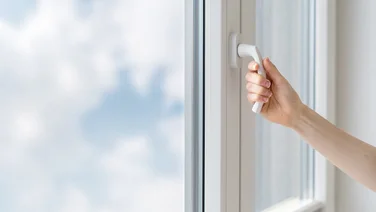- A soft cloth is best for cleaning uPVC windows with
- Blinds and curtains are great for preventing windows and doors from getting dirty
- Avoid harsh chemicals and opt for mild soap or detergent instead

Having uPVC (unplasticized polyvinyl chloride) windows means having windows that are durable, long-lasting, and great for improving the energy efficiency of your home.
Despite being low maintenance, you do still need to clean uPVC windows every now and then. Cleaning them is essential to making sure your uPVC windows last as long as possible.
However, it doesn’t need to be too much of a chore. Follow our handy guide on how to clean uPVC windows and you’ll see how easy it can be.
Plus, we’ve included top tips on keeping your windows clean, so you can save yourself from unnecessary future cleaning sessions.
If you’re ready to get new windows, we can help. Simply enter a few details in this form and we’ll connect you with our trusted installers. They’ll get in touch with bespoke double glazing quotes for you to compare.
What do I need to have to clean my uPVC window frames?
Before you start cleaning your uPVC window frames, you’ll need to gather a few essential items. Here’s a quick list:
- Warm water
- Mild soap or washing up liquid
- A window squeegee
The mild soap or washing up liquid is important, because you don’t want to use a harsh, abrasive chemical that might damage your windows (more on what to avoid further down the page).
How do I clean my uPVC window frames?
The best way to clean mould off uPVC windows is to use a combination of hot water and a soft cloth.
Ideally, you should start with the window frame itself, before moving onto the windows.
In short:
- Use a soft brush or soft cloth to brush off any dirt
- Rinse window frames with a hose, if possible, to remove dirt
- Make a warm water soapy solution with small amount of washing up liquid
- Use a soft cloth and the soap solution to wash down the frames and windowpane
You could also use this thrifty solution for cleaning your uPVC windows: mix one cup of vinegar (250ml, roughly) to four cups of hot water (about a litre). Put this mixture into a spritzer bottle and spray it onto the uPVC window frames.
After 10 minutes, dry it off with a clean cloth. Hey presto – not only a low-cost way to clean your uPVC windows, but an environmentally friendly one too!
However, if your uPVC frames have yellowed with age, it isn’t always possible to get them white again, especially if it’s a quality issue. It might be better, in that case, to get new window frames.
What should I NOT do when cleaning uPVC windows?
Using the right products when cleaning your uPVC windows is really important, because you don’t want to cause unnecessary damage and hasten having to get new windows.
Always try to avoid harsh chemicals or abrasive materials, as these can cause permanent damage to the uPVC surface.
Remember that some detergents use hidden colouring and when applied to a porous surface such as uPVC, it can stain the windows permanently.
Harsh chemicals to avoid include:
- Bleach – leaving bleach on a uPVC surface can turn the pristine white colour brown
- White spirit – this powerful solvent can cause irreparable damage to uPVC, as can methylated spirits
- WD40 – this can discolour and remove the shine of uPVC over time
- Window cleaner – you might think it’s odd to tell you not to use window cleaner, but save it for the windows themselves, because it can contain ammonia which can damage uPVC
Abrasive materials to avoid include:
- Scouring pad – using a scouring pad will do little in the way of cleaning, and lots in the way of scratching the uPVC
- Wire wool – much the same as a scouring pad, wire wool can scratch and permanently damage your uPVC window frames
When in doubt, stick with warm, soapy water and a bit of elbow grease. You can’t go wrong with this tried-and-test technique!
How do I clean uPVC window sills?
Cleaning uPVC window sills is much the same as cleaning uPVC window frames, so don’t worry about dramatically changing up your method. The only thing you’ll need to do differently is either dust or vacuum any excess dirt or debris off of the window sill before you get the liquids out.
After doing that, stick to the following:
- Using a warm water, soapy solution with a small amount of washing up liquid
- Trying the vinegar and water solution method (one cup of vinegar to four parts of hot water) for particularly stubborn stains
- Wiping with a soft cloth, or a non-scratchy sponge
How do I stop my uPVC window frames getting dirty in the first place?
Of course, one of the best things you can do to keep uPVC windows clean is to prevent them from getting dirty in the first place. Here’s our ideal cleaning routine to maintain your uPVC windows:
- Regularly wipe your uPVC windows down and clean your window frames at least once a month. Yes this is still cleaning them, but this will stop significant build-up of dirt and grime that if left, could become much harder to clean.
- Be aware of what’s coming from the outside if your windows are open. Hot, dry days can mean excess dust is in the air, and this can settle on your shiny white uPVC windows. Also, if there’s building work nearby, dirt and debris can drift through an open window.
- Use blinds or curtains to protect the window frames. These can help prevent dirt from getting a foothold on your uPVC in the first place.
How do I clean uPVC doors?
Cleaning uPVC doors is much the same process, thankfully. There’s some variation (like with cleaning uPVC window sills), but you’ll be following the same steps as listed earlier.
- Vacuum inside the door frame and hinges
- Brush off any visible dirt
- Use a warm, soapy solution (add small amount of washing up liquid)
- Apply the vinegar and water mix if there are especially resistant stains
- Rinse with clean water and use a soft window squeegee
There you go, a clean uPVC door that’ll look as good as a new one.
Summary
- Use warm water and soft liquids to clean uPVC windows and doors.
- Never use harsh chemicals such as bleach, white spirit, or WD40 to clean uPVC, as you can permanently damage it.
- Avoid abrasive materials such as scouring pads or wire wool too.
- Cleaning uPVC window sills and doors requires a little extra vacuuming or dusting to remove excess debris.
- If your uPVC windows are already discoloured and can’t be cleaned back to their original pristine white, it might be time to consider getting new windows.


